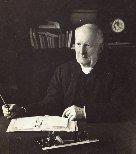


©2015 Deborah Richardson





Privacy Policy
Copyright




Schools underwent more reform in the later part of the 19th Century. New laws were passed, increasing the amount of time children had to spend in education.
In 1846/7 the Church of England conducted a very thorough Church School Inquiry report. At this time, Turvey had a Sunday School with 106 boys and 151 girls attending as well as a Daily Church of England school with 58 boys and 9 girls (clearly still hard to get the girls away from the lace pillows). There was also an Evening school with 20 boys and 50 girls! The Infant Sunday school had just 4 boys and 4 girls but the Infant Day school had 34 boys and 34 girls.

By 1852 there were 86 older children and 48 infants. There were five classes and the school was highly regarded. The students sat at two long desks, facing each other. The Library in the school now had a reading-
The master at this time, Rev. GFW Munby, says in his book 'Former Days at Turvey' that the children learnt that 'Prayer is the simplest form of speech that infant lips can try'. He also tells how they learnt many biblical stories
Night classes were held for farming boys and lace making girls in the long winter evening after they had finished their work. The Infant school also held a Sewing School on Saturdays to ensure that lace-
Munby explains how the infants learnt of the 'importance of Temperance principles and the evils to be dreaded from strong drink'.
The Rev. George Munby
The School buildings were also used for Parish Church Choir practice, Musical Society Concerts, Magic Lantern Lectures, Devotional Gatherings, Missionary Meetings and Sales of Work.
In 1864 the master of the National School was William Ward, and the mistress of the Infants was Sarah Ward. The master lived in the little cottage to the left of the school.
In 1869 it was first tried to force the lace making children to attend the village schools. Parents were not keen -
By the time of the 1870 Education Act, Turvey National Boy's School could accomodate 252 children and the National Infant's School could teach 123.
In 1872 the Government Inspector of Factories and Workshops stepped in to lay down the rules of the Workshops Acts. This helped and soon girls started attending. It was short lived however and within months girls were absent again as parents needed their wages at home. Education finally became compulsory in 1876.
At the time of the 1881 census, the Schoolmaster was 46 yr old Cameron S. Wooton of London. He was assisted in his duties by his 47 year old, Gloucester born wife, Emma.
Miss Margaret A. Parry, aged 33 and from Manchester, was the Mistress of the Infants school.
A 69 year old Turvey lady called Mary Toul or Tone was also listed as a Schoolmistress and Needlewoman but I do not yet know of which school.
Here are the balance sheets of the Turvey National Schools for the year ending November 30 1891, as presented to HM Inspector on December 8th and published in 'Homewords', the Turvey Parish Magazine -
|
Received |
£ |
s |
d |
Paid |
£ |
s |
d |
|
Balance on Dec 1st 1890 |
16 |
9 |
4 |
Salaries of Teachers |
122 |
0 |
0 |
|
Grant from Education Dept |
89 |
9 |
6 |
Salaries of Assistants |
10 |
5 |
0 |
|
Bequests to the school |
23 |
1 |
8 |
Salaries of Pupil Teachers |
15 |
0 |
0 |
|
Subscriptions |
50 |
0 |
1 |
Salaries of Monitors |
14 |
0 |
4 |
|
Payments of Scholars |
36 |
10 |
5 |
Books and Stationery |
8 |
7 |
9 |
|
Hire of Room |
2 |
3 |
4 |
Fuel, Light & Cleaning |
30 |
19 |
9 |
|
Sale of Work |
0 |
17 |
0 |
Repairs to building & furniture |
66 |
6 |
1 |
|
Balance Overdrawn |
46 |
4 |
4 |
Rates & Insurance |
2 |
12 |
9 |
|
|
|
|
|
Prizes |
1 |
15 |
4 |
|
|
|
|
|
Collecting, Subscriptions |
1 |
0 |
0 |
|
|
|
|
|
Materials for sewing etc |
1 |
10 |
8 |
|
Total |
273 |
15 |
8 |
|
273 |
15 |
8 |
By the 1920's the school children were given a third of a pint of milk each from Grove Farm.
Here is a picture of the class of 1922. There was no school uniform, many parents would not have been able to afford one. I think these children are in their Sunday Best.
My nan is in this picture, does anyone out there know anyone else?

For more wonderful old school photos, click here.
'O'er wayward childhood,
woulds't thou hold firm rule,
And sun thee in the light of happy faces, -
Love, Hope, and Patience,
these must be thy graces;
And in thine own heart let them first keep school.
Quote from Samuel Taylor Coleridge, hung on the School wall by Rev. GFW Munby, Rector of Turvey in 1853.
Click here for more information on Turvey Lower School nowadays.
Turvey Schools - After 1845

Miss Eleanor Maud Maclean was headmistress of Turvey Infant’s School from 1907 right up to 1947.
Here is the newspaper cutting of when she died, sadly it was not dated.
Click it to enlarge.

The Lower School has been a Grade II listed building since 1986.





